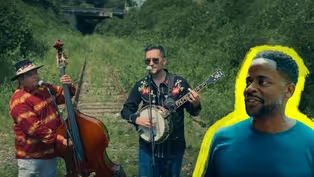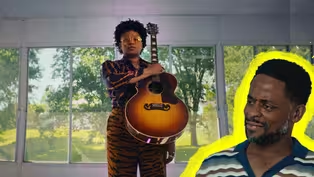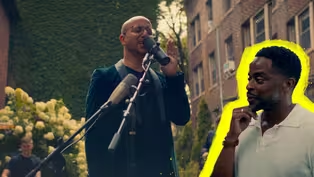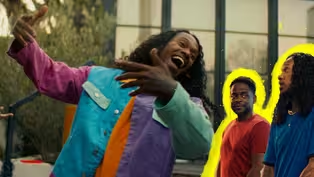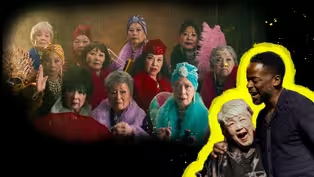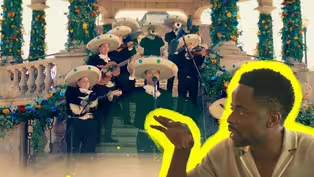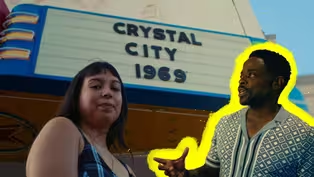
Dulé Hill’s History of Tap Dance
Special | 7m 45sVideo has Closed Captions
Dulé Hill shares his motivation for mastering tap dance and carrying its legacy forward.
Dulé Hill has been tap dancing since the age of three, and launched his career shortly after when he was cast in the national tour of the Broadway show, The Tap Dance Kid. Dulé explores his love of tap, and the history of this American dance form.
Problems playing video? | Closed Captioning Feedback
Problems playing video? | Closed Captioning Feedback
This program was made possible by a grant from Anne Ray Foundation.

Dulé Hill’s History of Tap Dance
Special | 7m 45sVideo has Closed Captions
Dulé Hill has been tap dancing since the age of three, and launched his career shortly after when he was cast in the national tour of the Broadway show, The Tap Dance Kid. Dulé explores his love of tap, and the history of this American dance form.
Problems playing video? | Closed Captioning Feedback
How to Watch The Express Way with Dulé Hill
The Express Way with Dulé Hill is available to stream on pbs.org and the free PBS App, available on iPhone, Apple TV, Android TV, Android smartphones, Amazon Fire TV, Amazon Fire Tablet, Roku, Samsung Smart TV, and Vizio.
Buy Now
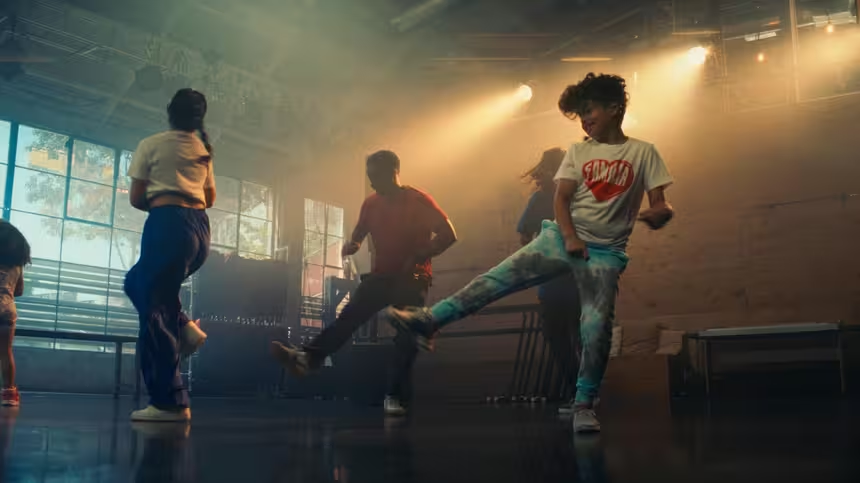
5 Artists Showcasing the Power of Art
From colorful cabarets and moving movies to artistic techniques that transcend the senses, here are five inspiring artists highlighted in The Express Way with Dulé Hill.Providing Support for PBS.org
Learn Moreabout PBS online sponsorshipMore from This Collection
Blending Latin Folk and Bluegrass Music
Video has Closed Captions
Larry & Joe are blending Latin folk and bluegrass music to show music has no borders. (16m 59s)
Finding Identity as a Black Appalachian Artist
Video has Closed Captions
Dulé Hill explores how music can provide solace and healing with musician Amythyst Kiah. (14m 51s)
Fighting for Syrian Refugees with Soul Music
Video has Closed Captions
A Syrian-American musician brings awareness to the civil war in his family’s homeland. (11m 32s)
Video has Closed Captions
Deaf dancer Shaheem Sanchez changes how Dulé Hill thinks about dance. (11m 42s)
Revitalizing Nightlife in San Francisco’s Chinatown
Video has Closed Captions
A multi-generational effort to preserve San Francisco Chinatown’s rich cultural history. (10m 3s)
Reimagining the Mariachi Charro Suit
Video has Closed Captions
Mariachi Arcoiris de Los Angeles reimagines the mariachi charro suit. (8m 36s)
Fighting for the Right to Speak Spanish
Video has Closed Captions
A new play tells the story of a Latino student walkout that changed history in Texas. (8m 13s)
Providing Support for PBS.org
Learn Moreabout PBS online sponsorship♪ Dulé Hill: I had the privilege of meeting some of America's most inspiring artists, each these using their art in transformative ways to heal, change society, and communicate with the world.
For me, tap is just that-- a beautiful language deeply rooted in the African diasporic experience.
Every rhythm, every step tells a story that transcends time.
♪ [Hill saying commands, indistinct] Now I'm going to sing the rhythm, and you all sing it back to me.
It goes "Da da da da."
Hill, voice-over: When I was a little boy and I first started to be exposed to tap, I was in awe of the fact that I could create these sounds, that I could create music.
I could say whatever I wanted to say.
Hill: Tap is just hearing the music in your head and bringing it to your feet.
Hill, voice-over: That's where my expression was at... Hill: Come on, now.
There you go.
There you go... Hill, voice-over: and that I could communicate with somebody.
Just do what I said with my feet and what they said back to me, and that we also could get in sync and do it together, say things together.
♪ [Cheering and applause] Hill: All right... [Laughter] That's what we call tap-dancing, man.
Man: You have tap dancers and then you have... [stresses second syllable] tap danc-ers.
Ha ha!
OK?
I'll tell you like it is.
Dulé fits under those "ers."
Ha ha!
You give him a step and he not only just taps, it's what he does with it.
Tap is an American form of dance, but the rhythms come from West African, the djembe drum.
See how I'm, like, on gravel?
♪ Oh ah ah... ♪ Whitmore, voice-over: The time step is one of the first principles of all of tap dancing, which is like the djembe drums that go... ♪ Bom ba bom bom, ka-dun, ka-dun-dun ♪ ♪ Hill: Djembe dancing drumming traces its roots back to the 12th-century Mandinka people and was later brought to America by enslaved West Africans.
But when early slaveholders banned the traditional drums, enslaved people found other ways to preserve the rhythms.
Whitmore: So they picked up rocks, sticks, bottles-- clink, clink, clink, clink-- to remember all that stuff.
You can break those rhythms down to your feet.
And everybody else wanted to get involved.
Hill: While enslaved Africans defiantly held on to and preserved their drum patterns and syncopated rhythms, European immigrants also arrived in the American colonies, bringing Irish, Scottish, and Dutch folk dancing with them.
Whitmore: The Irish, they had a rhythm, but it was not tap-dancing, and everything was from here on down.
That is it.
That's why they dance like this... Hill: Tap evolved from a tool of communication to a controversial American comedy act known as minstrelsy, in which mostly White performers would paint their skin black to imitate African-American dancers.
[Audience laughs] Whitmore: The minstrel shows become popular because in order for a White person to dance like that, they'd paint themselves black by exaggerating what a Black person did in dance form, and they would make money off of other people, and then they couldn't find good White tap dancers, so they would get Black people and paint them in blackface to go over to do the show and leave.
Then when you're really good, they said, "You need to be onstage."
And that's when you'd either go to medicine shows, carnival shows, or vaudeville.
Hill: Tap has seen over a century's worth of transformations, each bringing its own unique style, like that of Bill "Bojangles" Robinson and his famous stair dance in the vaudeville era, the trailblazing Nicholas Brothers, who fused jazz, ballet, and acrobatics during the Harlem Renaissance, and silver screen giants like Gene Kelly, who brought tap to forties and fifties Hollywood.
I first started dancing at the age of 3.
I was going to a dance school in East Orange, New Jersey.
I went there, really, because my mom was a ballet teacher there.
That was the first time I ever saw a pair of tap shoes and started to fall in love with it, and I've been in love with it ever since.
Man: Huh!
Hill: Harold Nicholas, I was in "The Tap Dance Kid" with him.
For a whole entire year, We toured around the country.
Dick Cavett: And here are two legends in their own time, Dulé Hill and Harold Nicholas.
♪ Harold Nicholas: Ah!
[Cheering and applause] Hill, voice-over: I'm appreciative that as a tap dancer, I've always been surrounded by people who look like me.
And Harold taught me so much of the history of the art form.
Tap, like many art forms, is passed on from one generation to the next, its popularity defined by the stars who carry the torch.
But by the late sixties, rock and roll, funk and soul captured the revolutionary spirit of America's youth, leaving vaudeville, Broadway, and tap out of step.
But then, thankfully, you had people who were like vessels to be able to hold on to the art form, protect the art form.
Gregory did it with tap.
Savion did it with "Bring in 'da Funk," showing how it was applicable to our existence as young Black men in the nineties.
It was a point of inspiration for a lot of talented younger artists who were coming up.
They were seeing what this group of tap dancers were doing and saying, "Well, why can't I do that myself?"
♪ Hill: Something like that.
[Cheering] [tap-dancing] ♪ [indistinct chatter] Hill: Hey.
[tap-dancing] Hey, there you go.
Doot.
Hill, voice-over: I think the popularity of tap today is always growing.
Man: Make some noise for Dulé Hill, y'all.
♪ I find inspiration in this generation of tap dancers coming out-- people like the Syncopated Ladies, who are marrying tap with social media.
Whitmore: The tappers today are great.
There's Jason Smith, Sarah Reich, Dormeshia Sumbry.
She's rated the world's best female tap dancer right now.
Hill: There are tap dancers everywhere doing it at a high level.
It's actually a beautiful thing to see because you know that you are a part of a journey, and then you see how it is expanding beyond your community that you were involved with.
Tap is so dear to me, and it's been an honor to help preserve and push the art form forward throughout my journey on "The Express Way."
It's a connective tissue, I think, throughout the world that if we can use our art to share and receive and share and receive, then maybe we can make this world a better place.
♪ [Cheering and applause] Man: The incredible Mr. Dulé Hill, y'all.
Hill: All right, y'all.
Hill, voice-over: Thanks for watching.
For more of "The Express Way" with me, Dulé Hill, you can tune in to the full-length series on the PBS app or your local PBS station.
Check out the link in the description to watch a full episode and find out more about the show.

- Culture

Trace Adkins joins the US Army Field Band in "Salute to Service 2025: A Veterans Day Celebration."













Support for PBS provided by:
This program was made possible by a grant from Anne Ray Foundation.
